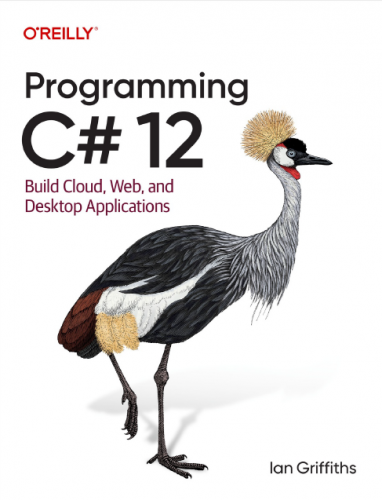- Joined
- May 24, 2024
- Messages
- 264
- Reaction score
- 434
- Points
- 43
- Thread Author
- #1
Programming C# 12

C# is undeniably one of the most versatile programming languages available to engineers today. With this comprehensive guide, you'll learn just how powerful the combination of C# and .NET can be. Author Ian Griffiths guides you through C# 12.0 and .NET 8 fundamentals and techniques for building cloud, web, and desktop applications.
Designed for experienced programmers, this book provides many code examples to help you work with the nuts and bolts of C#, such as generics, LINQ, and asynchronous programming features. You'll get up to speed on .NET 8 and the latest C# 11.0 and 12.0 additions, including generic math, new polymorphism options, enhanced pattern matching, and new features designed to improve productivity.
C# has now existed for around two decades. It has grown steadily in both power and size, but Microsoft has always kept the essential characteristics intact. Each new capability is designed to integrate cleanly with the rest, enhancing the language without turning it into an incoherent bag of miscellaneous features. Even though C# continues to be a fairly straightforward language at its heart, there is a great deal more to say about it now than in its first incarnation. Because there is so much ground to cover, this book expects a certain level of technical ability from its readers.
The C# programming language (pronounced “see sharp”) is used for many kinds of applications, including websites, cloud-based systems, artificial intelligence, IoT devices, desktop applications, embedded controllers, mobile apps, games, and command-line utilities. C#, along with the supporting runtime, libraries, and tools known collectively as .NET, has been center stage for Windows developers for over 20 years. Today, .NET is cross-platform and open source, enabling applications and services written in C# to run on operating systems including Android, iOS, macOS, and Linux, as well as on Windows.
C# 11.0 and 12.0 have gained performance-oriented features including generic math, and improved control over memory handling for performance-sensitive low-level code. Every new .NET release has improved execution speed, but there have also been significant reductions in startup times, memory footprint, and binary size. This, along with improved support for containerization, enhances .NET’s fit for modern cloud development. There have also been significant improvements for cross-platform client-side development, thanks to Blazor and .NET MAUI (Multi-platform App UI). .NET has supported ARM and WebAssembly (WASM) for many years, but continuous recent improvements for those targets are important for cloud, mobile, and web development.
This book helps you:
- Understand how .NET has changed in recent releases and learn what it means for application development
- Select the appropriate C# language features for any task
- Learn when to use the new features and when to stick with older ones
- Examine the range of functionality in .NET's class libraries
- Apply these class libraries to practical programming tasks
- Explore numerous small additions to .NET that improve expressiveness

C# is undeniably one of the most versatile programming languages available to engineers today. With this comprehensive guide, you'll learn just how powerful the combination of C# and .NET can be. Author Ian Griffiths guides you through C# 12.0 and .NET 8 fundamentals and techniques for building cloud, web, and desktop applications.
Designed for experienced programmers, this book provides many code examples to help you work with the nuts and bolts of C#, such as generics, LINQ, and asynchronous programming features. You'll get up to speed on .NET 8 and the latest C# 11.0 and 12.0 additions, including generic math, new polymorphism options, enhanced pattern matching, and new features designed to improve productivity.
C# has now existed for around two decades. It has grown steadily in both power and size, but Microsoft has always kept the essential characteristics intact. Each new capability is designed to integrate cleanly with the rest, enhancing the language without turning it into an incoherent bag of miscellaneous features. Even though C# continues to be a fairly straightforward language at its heart, there is a great deal more to say about it now than in its first incarnation. Because there is so much ground to cover, this book expects a certain level of technical ability from its readers.
The C# programming language (pronounced “see sharp”) is used for many kinds of applications, including websites, cloud-based systems, artificial intelligence, IoT devices, desktop applications, embedded controllers, mobile apps, games, and command-line utilities. C#, along with the supporting runtime, libraries, and tools known collectively as .NET, has been center stage for Windows developers for over 20 years. Today, .NET is cross-platform and open source, enabling applications and services written in C# to run on operating systems including Android, iOS, macOS, and Linux, as well as on Windows.
C# 11.0 and 12.0 have gained performance-oriented features including generic math, and improved control over memory handling for performance-sensitive low-level code. Every new .NET release has improved execution speed, but there have also been significant reductions in startup times, memory footprint, and binary size. This, along with improved support for containerization, enhances .NET’s fit for modern cloud development. There have also been significant improvements for cross-platform client-side development, thanks to Blazor and .NET MAUI (Multi-platform App UI). .NET has supported ARM and WebAssembly (WASM) for many years, but continuous recent improvements for those targets are important for cloud, mobile, and web development.
This book helps you:
- Understand how .NET has changed in recent releases and learn what it means for application development
- Select the appropriate C# language features for any task
- Learn when to use the new features and when to stick with older ones
- Examine the range of functionality in .NET's class libraries
- Apply these class libraries to practical programming tasks
- Explore numerous small additions to .NET that improve expressiveness
HIDEREPLYREACT=1,2,3,4]
https://pixeldrain.com/u/3ejnR9df
[/HIDEREPLYREACT]

